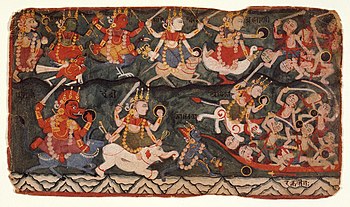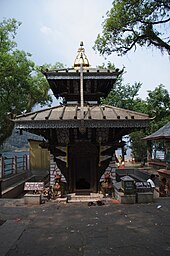Varahi
Varahi (Sanskrit: वाराही, IAST:Vārāhī)[note 1] is one of the Matrikas, a group of seven mother goddesses in the Hindu religion who bears the head of a sow.
According to the Shumbha-Nishumbha story of the Devi Mahatmya from the Markandeya Purana religious texts, the Matrikas goddesses appears as shaktis (feminine powers) from the bodies of the gods.
In the Raktabija episode, Varahi is described as having a boar form, fighting demons with her tusks while seated on a preta (corpse).
Varahi, with other Matrikas, is created by Shiva to help him kill the demon Andhakasura, who has the ability – like Raktabija – to regenerate from his dripping blood.
[8] The Devi Purana paradoxically calls Varahi the mother of Varaha (Varahajanani) as well as Kritantatanusambhava, who emerges from Kritantatanu.
Pal theorizes that the name "Vaivasvati" means that Varahi is clearly identified with Yami, the shakti of Yama, who is also known as Vivasvan.
Moreover, Varahi holds a staff and rides a buffalo, both of which are attributes of Yama; all Matrikas are described as having the form of the gods, they are shaktis of.
[13] The Lalita Sahasranama, a collection of 1,000 names of the Divine Mother, calls Varahi the destroyer of demon Visukaran.
[14] In another context, Varahi, as Panchami, is identified with the wife of Sadashiva, the fifth Brahma, responsible for the regeneration of the Universe.
[10] In yet another context, Varahi is called Kaivalyarupini, the bestower of Kaivalya ("detachment of the soul from matter or further transmigrations") – the final form of mukti (salvation).
Varahi is described as residing in a person's navel and governs the manipura, svadhisthana and muladhara chakras.
[15] Haripriya Rangarajan, in her book Images of Varahi—An Iconographic Study, suggests that Varahi is none other than Vak devi, the goddess of speech.
[19] Varahi is usually depicted with her characteristic sow face on a human body with a black complexion comparable to a storm cloud.
[19][21] One belief suggests that since Varahi is identified with the Yoganidra of Vishnu, who holds the universe in her womb (Bhugarbha Paranmesvari Jagaddhatri), she should be shown as pot-bellied.
The Rupamandana says she carries a ghanta (bell), a chamara (a yak's tail), a chakra (discus) and a gada (mace).
[2][17][23] The Purva-Karanagama mentions that she holds the Sharanga (the bow of Vishnu), the hala (plough) and the musula (pestle).
[16] The Aparajitapriccha describes her holding a rosary, a khatvanga (a club with a skull), a bell, and a kamandalu (water-pot).
[24] The Vishnudharmottara Purana describes a six-armed Varahi, holding a danda (staff of punishment), khetaka (shield), khadga (sword) and pasha (noose) in four hands and the two remaining hands being held in Abhaya and Varada Mudra ("blessing gesture").
[8] When depicted as part of the Sapta-Matrika group ("seven mothers"), Varahi is always in the fifth position in the row of Matrikas, hence called Panchami ("fifth").
[16] Varahi is worshipped in the Sapta-Matrikas group ("seven mothers"), which are venerated in Shaktism, as well as associated with Shiva.
These practices are observed in the Kalaratri temple on the bank of the Ganges, where worship is offered to Varahi only in the night; the shrine is closed during the day.
Here, Barahi, as she is known as in Nepal, is worshipped in the Matysa Varahi form as an incarnation of Durga and an Ajima ("grandmother") goddess.
The hog head is described in Tibetan scriptures as representing the sublimation of ignorance ("moha").
In the Sarvatathagatatattvasamgaraha, Varahi is described initially as a Shaiva sarvamatr ("all-mother") located in hell, who is converted to the Buddhist mandala by Vajrapani, assuming the name Vajramukhi ("vajra-face").






